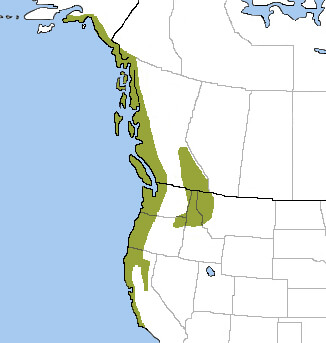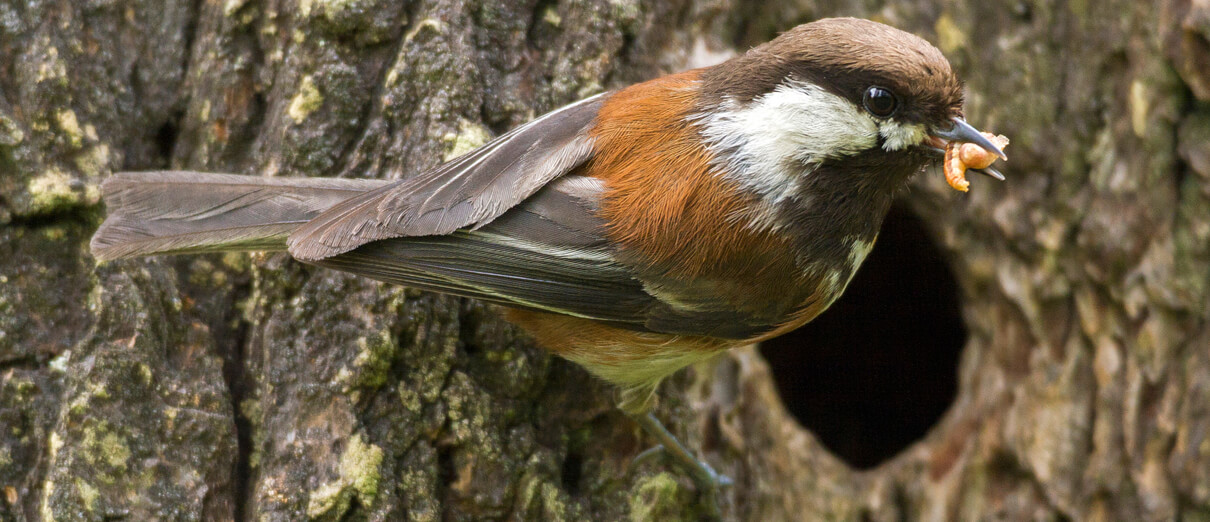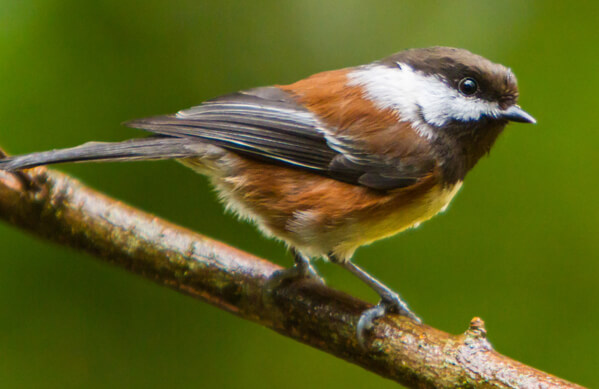
Chestnut-backed Chickadee range map by American Bird Conservancy
Of North America's seven chickadee species, the Chestnut-backed and the Carolina are the smallest. But for the title of most colorful, the Chestnut-backed wins hands down, with its reddish-brown back, rump, and sides, set off by a dark cap.
The Chestnut-backed Chickadee is confined mostly to mature coniferous forests along the Pacific Coast and in the Northern Rockies. In places, its range overlaps with those of three related species: the Mountain Chickadee, Boreal Chickadee, and the larger and more common Black-capped Chickadee.
A Tricky Trill
Unlike most chickadee species, the Chestnut-backed does not have a whistled song. Instead, it sounds off with a series of dry chip notes more reminiscent of a sparrow. Its call, however, is a variant of the more familiar chick-a-dee-dee, similar to other close relatives.
Listen here:
(Audio: Chestnut-backed Chickadee song by Frank Lambert, XC269229. Accessible at www.xeno-canto.org/269229. Chestnut-backed Chickadee call by Andrew Spencer, XC143245. Accessible at www.xeno-canto.org/143245. Black-capped Chickadee song by Ted Floyd, XC350304. Accessible at www.xeno-canto.org/350304)
Conifer Chickadee
The Chestnut-backed Chickadee inhabits humid coastal and interior forests stretching from southeastern Alaska to central California. It is partial to dense forests of Douglas-fir, spruce, and cedar, which it shares with species such as the Townsend's Warbler and Varied Thrush.
This chickadee species has expanded its geographic range over the past 50 years to forests of the central Sierra Nevada and suburban areas in eastern San Francisco Bay. Long-term fire suppression efforts, which create the denser habitat this species favors, may be partly responsible for this expansion. Although still common in most places, Chestnut-backed Chickadee populations declined by about 56 percent between 1966 and 2015, according to North American Breeding Bird Survey data.
This hardy songbird does not migrate, although some may move short distances in response to food availability. There are three subspecies, distinguished by the intensity of chestnut color on the sides and flanks. The central California subspecies, for example, is pale gray below, with just a hint of chestnut on its flanks.
Frenetic Foraging
The Chestnut-backed Chickadee is an active feeder, constantly gleaning twigs and branches and probing bark crevices in search of small insects and spiders, and their larvae. It's often spotted hanging upside-down, checking the undersides of needles and leaves. It will also hover to pick off prey, or dart out to nab flying insects mid-air like a Pacific-slope Flycatcher, a species with which it shares much of its range during the breeding season.
Besides invertebrates, the Chestnut-backed Chickadee's diet includes conifer buds and seeds, and fruit, particularly outside of the breeding season. Like the American Goldfinch or Tufted Titmouse, this bird also visits backyard feeders for seeds, nuts, and suet.
During the winter, the Chestnut-backed Chickadee maximizes its feeding options and security by joining mixed-species foraging flocks that often include the Red-breasted Nuthatch, Golden-crowned and Ruby-crowned Kinglets, and Brown Creeper.

Chestnut-backed Chickadee at nest cavity. Photo by Danita Delimont/Shutterstock
Extra-Snug Nests
Like other chickadees and the White-breasted Nuthatch, the Chestnut-backed Chickadee is a "secondary" cavity nester, most often reusing an old woodpecker hole for a nest site. However, a mated pair will sometimes excavate their own nest cavity in a soft, rotten branch.
Inside the chosen cavity, the female builds her nest of moss, strips of bark, feathers, and, most importantly, animal fur, which provides extra insulation and warmth in this bird's damp, cold environment. Chestnut-backed Chickadee nests are usually at least half fur and hair, most commonly from deer, rabbit, coyote, or livestock. The female also makes a "blanket" of fur, about a quarter-inch thick, to keep the eggs warm and covered when she leaves the nest. She broods her eggs and nestlings alone, although the male brings food to the nest for her and their chicks.
Chestnut-backed Chickadees will reuse a prime nest site over several years, and will readily accept nest boxes.
Chickadee Conservation
As is the case with many other birds, this species is most at risk from habitat loss. ABC continues to advocate for the conservation of old-growth forests in the Pacific Northwest, which provide habitat for the Chestnut-backed Chickadee and other species, including the Threatened Northern Spotted Owl and Marbled Murrelet.
Donate to support ABC's conservation mission; 1:1 match through Dec. 31!



















































